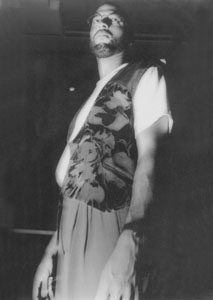Anything But Silent
Jazz keyboardist Andy Milne takes his rhythm cue from Steve Coleman
By Nicky Baxter
FRIDAY NIGHT at Oakland's Upper Room, and improvisational-jazz standard bearers Steve Coleman and Five Elements sound like musicians possessed. Following a solo at once mathematically precise and incandescent, alto saxophonist Coleman retreats. Three rappers move forward. Almost immediately, their free-styling sound elicits whoops of approval from the crowd.
Behind them, the Five Elements (nine if you include the dancers) are whipping up a tempest. Stage right, Canadian-born keyboard player Andy Milne grins maniacally. His hands splayed out over the electronic ivories, he works one chord to death, creating a crazy beautiful din.
Maybe Milne was inspired by the club's sweaty synergism, maybe he was giddy from exhaustion or maybe he simply wanted to make his own statement, something Coleman, like other great jazz band leaders, encourages. In a talk after a summer workshop sponsored by the Community School of Arts and Music in Mountain View, Milne discussed Coleman as well as his own current, self-produced recording, Andy Milne--The "E" Is Silent
Milne met Coleman six years ago in Montreal, where the latter was an instructor at a "progressive" music school. "I had never heard of him," the lanky, affable musician admits. "He started asking all of us [students] what it was we really wanted to do in music. He encouraged us to think critically--not just about music but life. A lot of people didn't want to do that."
Milne wasn't one of them; he found himself gravitating toward the alto player. Barely in his 30s, Coleman could connect with his youthful protégé, then in his early 20s. Milne was an exceptional student, digesting class notes and struggling to understand Coleman's complex tunes.
After graduating, the keyboard player packed it in for New York City, with just a couple of phone numbers and no definite gigs to speak of. But one of those numbers belonged to Coleman, so Milne wasn't worried. In fact, just before he crossed the border, Milne had been referred by Coleman to singer Cassandra Wilson.
"I was a bit slow in responding," he concedes, somewhat embarrassed. "When I finally got up enough nerve to call her, it was too late." Milne did eventually audition for Wilson and has toured with her when his workload permits.
Right now, Milne's schedule is a delicate balancing act. When he's not touring America and Europe with the Five Elements, he is on the road on low-rent DIY tours with his own unit, a quartet that features bassist Matthew Garrison and drummer Gene Lake. Interestingly, this rhythm section has also performed with the Five Elements, though only for a short while.
Even more interesting is how unlike Coleman's distinctive brand of structured improvisation some of Milne's music sounds. The "E" Is Silent relies less on repeated rhythmic patterns and vertiginous improvisation and more on the "traditional" verse-chorus-solo structure.
MILNE'S PLAYING assumes greater primacy on The "E" Is Silent; his true voice emerges with a sense of purpose impractical in other contexts. Performing on synthesizer and clavinet, Milne clearly owes a debt to Headhunter-era Herbie Hancock, while his acoustic piano work bears the stamp of a wider range of influences, most notably Art Tatum and Ahmad Jamal.
"Neoparadeigma" is not quite as obscure as its title suggests; indeed, it evokes style of pop-jazz popularized by Hancock and George Duke. The choppy clavinet figure that introduces the tune sounds particularly Duke-ish. Just when the listener starts to feel self-satisfied, Milne switches to piano and fashions a comely solo that would do Jamal proud. Before Milne and company are done, they guide us through a miniseries on modern jazz and a number of its variants.
Back at the Upper Room, Milne leans into another succinct angular solo, grinning goofily at his mates. At this moment, he looks as if there is no better place than this, no better bunch of musicians to bounce sounds off than this one. Whether he sticks with the Five Elements another four years or strikes out on his own, one thing appears certain, Milne will continue to mature.
"[Artistic growth] is like a funnel," he says. "The older you get, the wider it gets. For me, the funnel was like a 'V'; now, hopefully, it's much wider."
[ Metro | Metroactive Central | Archives ]
This page was designed and created by the Boulevards team.

Vested Interest: On his album "The 'E' Is Silent,' Andy Milne harkens back to Herbie Hancock, Ahmad Jamal and even Art Tatum.
For information about The "E" Is Silent, write to Triborg Publishing, 400 12th St., #2, Brooklyn, New York 11215. Email: [email protected].
From the October 31-November 6, 1996 issue of Metro
Copyright © 1996 Metro Publishing, Inc.
![[Metroactive Music]](/music/gifs/music468.gif)